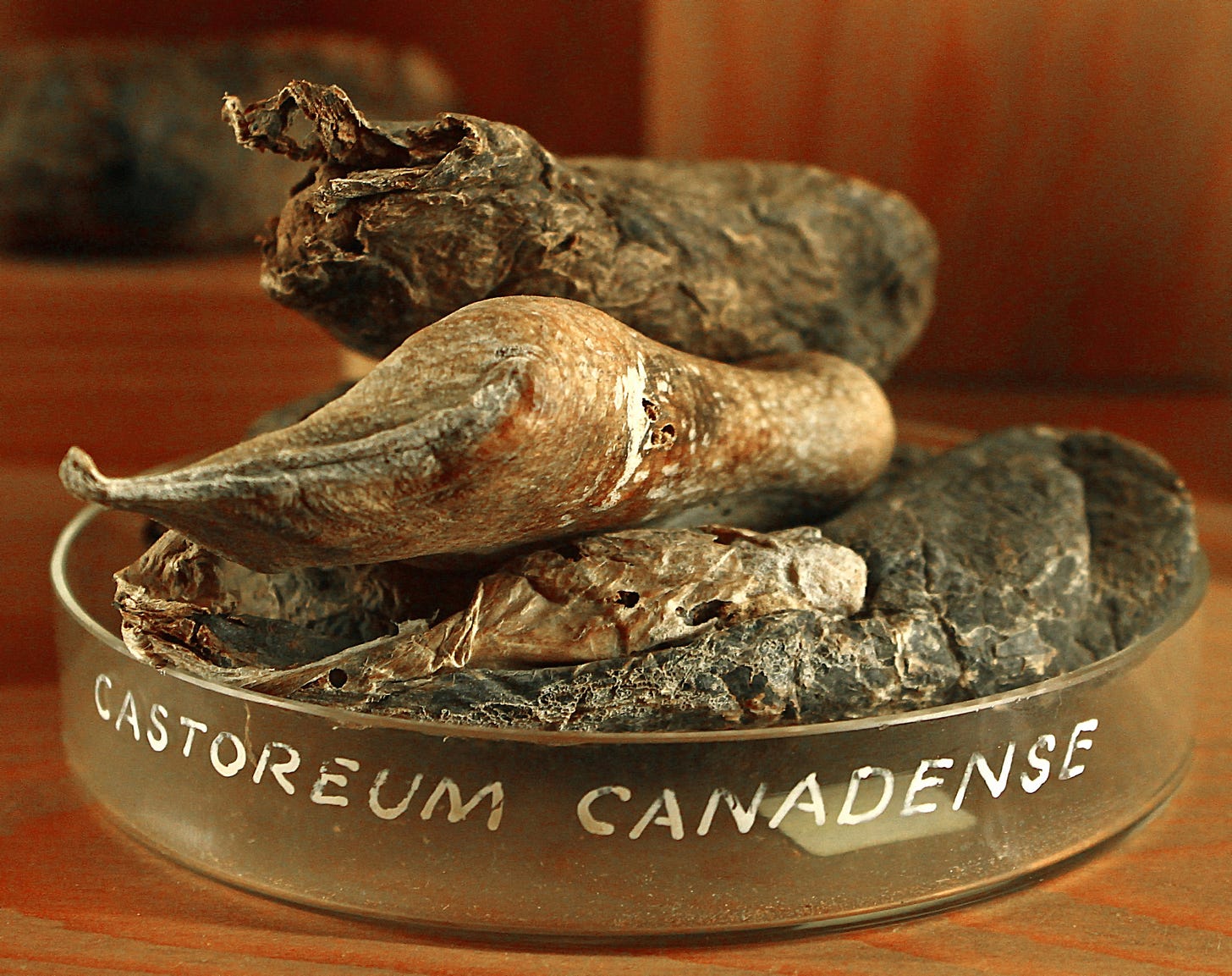Imagine finishing a whole gallon of ice cream, midway through a solid 6/10 rom-com, only to learn it was flavored with a secretion from a beaver’s backside.
I’d imagine you’d be pretty upset. Maybe even feeling a little ill.
Or maybe you’re sipping an expensive bourbon at a swanky hotel bar, dressed up to the nines and feeling all sophisticated. As you swirl the caramel coloured liquid around the crystal glass, you take in the rich oaky notes, basking in the enticing aroma.
The rich, oaky aroma that is luring you in is actually the whisper of a woodland rodent.
Pretty ludicrous, right?
Well maybe not. I'd like to introduce you to Castoreum.
Castoreum is a musky aromatic secretion from a gland located near a beaver's tail. It’s been used by humans for centuries in everything from medicine to perfume to today’s subject, food flavourings.
The internet is rife with claims that artificial vanilla, raspberry, and strawberry flavors contain ‘beaver butt juice.’ The truth? More complicated, and just as bizarre.
In this post, we’ve going to explore this claim. We’re going to find out if we are unknowingly consuming castoreum in the modern world. And perhaps most importantly we’re going to try to unearth which absolutely insane person thought it was a great idea to squeeze a beaver dry and stick the harvested material into food.
What Is Castoreum, Anyway?
First things first: castoreum is not poop
It doesn’t even come from a beaver’s anus, though it’s definitely in the ‘danger zone.’
Beavers, as it turns out, are surprisingly fragrant. Along with their iconic flat tails and tireless work ethic, they also have castor sacs, small glands located next to their anal glands. Think of them as jolly neighbors, like Homer and Ned or Fred and Barney.
These sacs secrete a sticky, yellowish-brown substance known as castoreum, which the beaver uses to mark its territory, a sort of "No Trespassing" sign for other beavers.
Now I know what you are thinking. “Sticky”, “Yellowish-Brown”, “No Trespassing” - Surely this substance smells absolutely revolting?!
Here’s where things get really interesting: thanks to the beaver’s diet of tree bark, leaves, and other plant matter, castoreum doesn’t smell like a swampy rodent rear end.
It actually smells… nice.
Sweet, musky, vanilla-like. Which is why humans, being the mad creatures that we are, eventually decided to test it out in food and perfume.
So in summary: Beavers are out there, perfuming their own butts with a natural essence of vanilla and woodsiness by eating bark. At some point, someone thought: We should eat that.
How Castoreum Went from Beaver Bums to Banquets
Now that we know what castoreum is, the real question is: Who was the first person to think, ‘Let’s eat that’?
Castoreum’s first recorded use wasn’t in food, it was in medicine. The Ancient Romans, always keen to rub animal parts on themselves in the name of health, believed it could cure everything from epilepsy to hysteria.

Medieval doctors prescribed it for headaches, fevers, and (for reasons best left unexplored) even as a treatment for “excessive female desire.”
Sounds ridiculous, right? But let’s be honest: If your doctor told you to ingest something extracted from a beaver’s backside twice a day, you might not feel particularly frisky either.
By the Renaissance, castoreum had made its way from the apothecary to the banquet hall. It became one of several exotic animal-derived flavourings, alongside musk (from deer glands), ambergris (a whale-derived perfume), and civet (an ingredient from civet cats). The Persian Sultan’s Book of Delights, a 15th-century cookbook, even included recipes for musk-infused samosas and ambergris-laced puddings.
By the early 20th century, castoreum had entered the flavor industry. It wasn’t used as a cheap substitute for vanilla, despite what the internet says, but as a luxury ingredient prized for its depth and complexity. In tiny amounts, it enhanced vanilla, raspberry, and strawberry flavors, adding a richness that artificial alternatives couldn’t match
It was essentially a luxury ingredient added to only the finest of products.
At its peak, you could find castoreum in fancy vanilla ice cream, premium chocolates, and even certain brands of chewing gum. It's primary use was as a "natural flavoring" in certain foods, particularly in vanilla, raspberry, and strawberry-flavored products
If you were a smoker in the 1960s, you might have been inhaling beaver extract. Cigarette makers used it to give brands like Camels and Winstons their “luxurious aroma.”
Despite its long history, castoreum’s days in food were numbered…
The Fall of Beaver Butt in Our Food
If castoreum was once such a prized ingredient, why did it disappear from our food?
Well… technically, it hasn’t. Castoreum can still be labeled as 'natural flavoring,' making it nearly impossible to know if it’s in your food.
That said, the chances of you unknowingly eating beaver gland juice are incredibly slim, and the reasons are surprisingly practical
It’s Expensive and Hard to Harvest – Unlike synthetic flavorings, which can be mass-produced in a lab, castoreum extraction is… well, personal. A trapper has to physically extract it from beavers—by hand. Imagine sitting a beaver down, putting on some Barry White, and massaging out the goods. Awkward for everyone involved.
It’s Not Kosher (Literally) – Since castoreum is an animal product, it instantly disqualifies any food hoping for kosher certification. And for a lot of food companies, losing that market was a deal-breaker.
Synthetic Chemistry Took Over – By the late 20th century, food scientists had developed cheaper and more efficient ways to mimic vanilla and fruit flavours using synthetic chemicals. No beavers required.
So, just how expensive is castoreum today? If you’re in the market for some, here’s what you’re looking at:
Dried beaver castoreum glands (primary source):
$50-$75 per pair for "well-handled" glands from trappers (Trapper Mag)
$90 for 100-120g pair of premium dried glands (Bill Worb Furs)
£32.04 ($40) for 40g dried European beaver gland on (eBay)
Processed castoreum:
$80-$100 per pound (trapper market rate)
$20-$250 for liquid castoreum tinctures (Kishel's Scents)
€30.29 ($33) for 1ml castoreum in sandalwood oil (Etsy)
Not sure I'd grab my beaver castoreum glands from Etsy or Ebay, but there you go.
Castoreum quietly faded from industrial food production. By 1987, the amount of castoreum used in food had dropped to just 250 pounds per year in the U.S, a tiny fraction of the million-pound flavouring industry.
Today, it’s virtually non-existent in mainstream food, and major flavour manufacturers say they don’t use it at all anymore.
This all means you can rest easy in the knowledge that your strawberry yoghurt hasn’t been tainted by a beaver's taint. But that doesn’t mean the castoreum has disappeared entirely…
The Unexpected Revival
Just when you thought the world had moved on from beaver gland juice, craft distillers in New Hampshire decided to bring it back, this time, in bourbon.
Tamworth Distilling, a heritage-obsessed liquor company, created Eau de Musc, a bourbon infused with castoreum and other woodland botanicals.
The goal?
To capture the “mood of the forest” in a glass.
Nothing says "mood of the forest" like a drop of beaver castor gland juice.
The distillery sources its castoreum from local trappers, who harvest it from beavers taken as part of population control efforts.
The result?
A whiskey with woody, leathery, slightly raspberry-like notes, which, if nothing else, will get a conversation started.
But Tamworth isn’t the only place keeping castoreum alive.
Swedish trappers still make Bäverhojt, a traditional beaver-infused schnapps. And while it’s largely vanished from food, castoreum remains a prized ingredient in high-end perfumes, where it adds depth, muskiness, and a hint of smoky sweetness.
So… Should We Be Eating More Beaver Butt?
Given its long history and intriguing flavour profile, should we be embracing castoreum instead of running from it?
Some say yes. If beaver culling is necessary for ecological balance, why let a perfectly good ingredient go to waste?
Others, understandably, can’t get past the whole ‘this was secreted from an animal’ part.
But whether or not castoreum makes a culinary comeback, one thing is certain: next time someone tells you that your vanilla latte is full of beaver butt juice, you’ll be armed with the facts, and maybe, just maybe, you’ll be a little disappointed that it isn’t.






